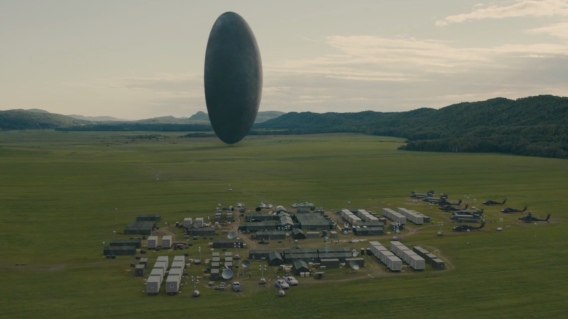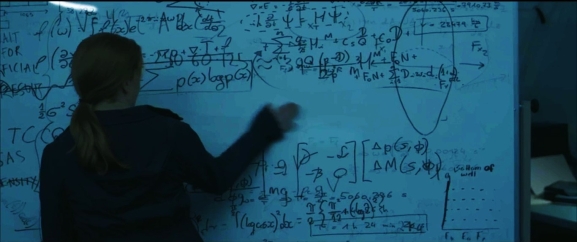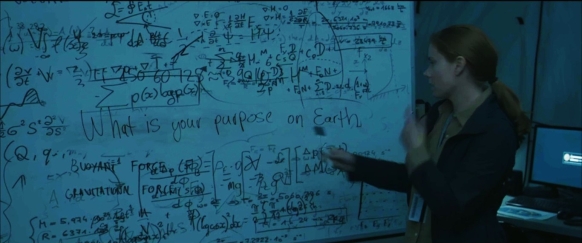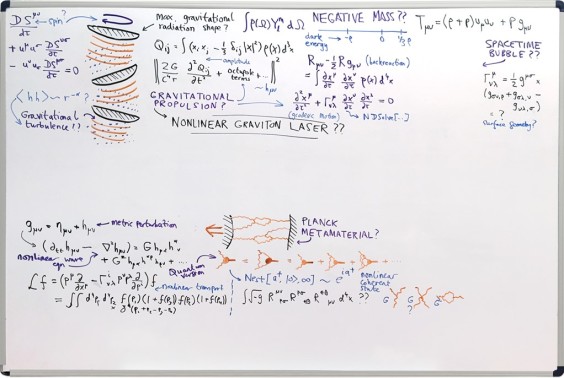Why do we distinguish between the past, present, and future? Is it a fundamental property of the universe, or is it linked to our own unique perception of time?
This is a key question tackled in Arrival, a sc-fi thriller depicting the first contact between humans and extra-terrestrials. The film follows the linguist Louise Banks, who has been recruited by the US government to establish communication with strange squid-like beings that recently landed on Earth.

While the plot is very interesting from a linguistics point of view, Arrival also includes some nice physics hidden in the background. In particular, the film explores the way that we experience time. While humans perceive time as always flowing in one direction with the future hidden from our view, the aliens in the film view time in a more holistic way, with no distinction between past, present, and future. Eventually, Louise becomes able to see time in the same way, catching glimpses of her future as she learnt more of the alien language.
Our perception of time
The way we all experience time, marching inexorably into the future while leaving the past behind, is something which has puzzled physicists for a long time. The equations that determine motion in classical (as well as quantum) physics don’t specify an ‘arrow’ of time. These equations work just as well whether time is going backwards or forwards. Although not mentioned explicitly in the film, the short story the film is based on, ‘Story of Your Life’ by Ted Chiang, deals with this idea, particularly in relation to an area of physics called Lagrangian mechanics.
Lagrangian mechanics is a more sophisticated formulation of the traditional classical mechanics created by Newton, revealing symmetries and conserved quantities in physical systems. One cool idea related to Lagrangian mechanics is the principle of least action. This principle states that the path taken by an object between two points must be such that it minimises a (somewhat abstract) quantity called the ‘action’. One example of this used in Chiang’s story is Fermat’s principle, which says that a ray of light will always take the path between two points that takes the least time. According to some interpretations, the light must ‘know’ where it is going to end up before it can start taking that path. Therefore Fermat’s principle seems to be suggestive of the future somehow influencing the present. In The Story of Your Life, when attempting to communicate with the aliens, Fermat’s principle was the only thing the aliens seemed to recognise in the humans’ writing. In the film, the only reference to the principle is when it is mentioned that the aliens are taking interest in some ‘more advanced’ physics.

In my opinion (and some others’), Lagrangian mechanics doesn’t really have these teleological implications, although I recognise that this is a controversial issue. All that the least action principle is saying is that given a starting point and ending point, the path taken minimises the action. While the endpoint in some sense determines the path, the choice of point is arbitrary – it could be any point. And the path of an object can be equally determined without knowing the end point, by instead having knowledge of the position, velocity, and the forces acting upon it.
But this doesn’t take away from the idea of aliens with a different perception of time to us. And this isn’t actually as farfetched as it may seem. As I mentioned before, the equations governing classical and quantum mechanics don’t indicate any ‘arrow’. So why does time seem to flow in one direction? Most physicists agree the answer to this question is entropy. Loosely, entropy quantifies the amount of ‘disorder’ in a system. A pack of shuffled cards has relatively high entropy compared to a pack ordered by number and suit. The interesting thing about entropy is that it tends to increase with time: if you shuffle an ordered pack of cards, it’s going to become disordered, but if you shuffle a disordered pack of cards, it’s extremely unlikely to become more ordered. This is because there are many more disordered configurations than ordered ones. So entropy is a physical law that definitely seems to point time in one direction.
However, entropy is a statistical concept relating to groups of huge numbers of particles. But what if we look at a single particle? Could we see the flow of time then? As proposed in The Order of Time by Carlo Rovelli, humans perceive time because we see the universe on a macroscopic scale. When we go down to the quantum scale, time breaks down – it is only through the ‘blurriness’ of our worldview that time emerges.
So could aliens with a different perspective of time theoretically exist? The idea seems plausible.
Whiteboard curiosities
This is all and well, but is there any physics actually referenced in the film? Apart from some indirect references, the only real physics we see is a brief shot of a whiteboard covered in mathematical equations presumably written by Ian Donnelly, the physicist hired by the military to assist with investigating the alien technology. Although we only get a few glimpses of the whiteboard, you can tell a lot of work went into creating it.
Here it is in a couple of shots.


Looking at these two shots closely, the first thing that becomes apparent is that the whiteboards are not exactly the same – even though the two shots were only about one second apart! It seems that the filmmakers changed the board between takes of this scene, and then spliced the shots together. To be fair, only someone analysing the film frame by frame would ever notice this…
Continuity issues aside, the board contains a mess of equations from different areas of physics. As discussed in this blog by a mathematician at Harvard, you can see Schrödinger’s equation, Maxwell’s equations, a line integral, and a formula for the Shannon entropy. Although these all have important functions, it doesn’t really paint a very coherent picture of what Prof Donnelly was trying to achieve.
More interesting to me is the fact that the producers originally asked Stephen Wolfram (creator of Mathematica) to design the whiteboard, and then curiously decided not to use it. This is all recounted in Wolfram’s blog, where he talks about how he basically designed an interstellar spacecraft in one evening, propelled by gravitational waves. He also filled in a whiteboard with the relevant physical equations (which he explains in detail).

This whiteboard seems much more like what a professional physicist would write (which it was), and is more consistent with the details of the film. Maybe the filmmakers thought there was something more aesthetic about a messy whiteboard crammed with random graphs and equations…
In any case, Arrival is a thought-provoking film, exploring what the first contact with an intelligent alien species might be like. While a lot of the physics seems to have been lost from the original short story, you can still find some underlying concepts hinted at throughout the film. The aliens’ holistic view of time is not only interesting as a plot device, but is also relevant to current debates in physics. Definitely a film with rewatch value.
Hi, what is the citation for this article? Who is the author?
LikeLike
Hi Aisha, thanks for reading! My name is Andre Chambers and see here for citing this blog post: https://www.easybib.com/guides/citation-guides/how-do-i-cite-a/how-to-cite-a-blog/
LikeLike